Microgreens Side Effects: What You Need to Know
Microgreens are young, edible seedlings of various plants. They are also known as micro herbs or vegetable confetti. These tiny greens are packed with vitamins, minerals, and antioxidants. They are great as a garnish, salad addition, or snack.
Microgreens are known for their high nutrient content. They have more vitamins, minerals, and antioxidants than regular vegetables. This makes them a popular choice for health-conscious eaters.
But, it’s important to know about the potential risks of microgreens. There’s a chance of contamination during the growing process. This could lead to foodborne illnesses.
Key Takeaways
- Microgreens contain up to 9 times the nutrients of mature vegetables
- Microgreens are a rich source of vitamins, minerals, and antioxidants
- Potential side effects include risk of contamination and foodborne illness
- Proper growing, handling, and storage practices are crucial for safety
- Incorporating microgreens into a balanced diet can provide significant health benefits
Understanding Microgreens
Microgreens are tiny, packed with nutrients. They are the young versions of common vegetables and herbs. Harvested when the first true leaves appear, they are much younger than regular greens.
Definition of Microgreens
Think of microgreens as the young cousins of veggies like kale and spinach. They grow in soil, which helps their roots and leaves develop fully. This is different from sprouts, which grow in water and are picked even sooner.
Differences Between Microgreens, Sprouts, and Mature Vegetables
Microgreens, sprouts, and mature vegetables are all greens, but they grow and are used in different ways. Sprouts are seeds that haven’t yet developed their leaves. Microgreens are harvested after their first leaves appear. And while sprouts grow in water, microgreens grow in soil.
Microgreens are picked much earlier than mature vegetables. This means they have a higher nutrient density.
- Sprouts: Germinated seeds harvested before first true leaves emerge, grown in water
- Microgreens: Tiny seedlings harvested after first true leaves develop, grown in soil or soil-like medium
- Mature Vegetables: Fully-grown plants, harvested after complete development
Knowing these differences helps us see why microgreens are special. They offer unique qualities and benefits not found in other greens or vegetables.
Common Types of Microgreens
Microgreens have become very popular in recent years. They are now a key part of many gourmet kitchens and homes. These small, packed-with-nutrients greens come from different seeds. They add unique flavors, colors, and textures to dishes.
Nutrient-Dense Varieties
Mustard greens, alfalfa, broccoli, and radish are some of the most nutrient-rich microgreens. They are full of vitamins, minerals, and compounds like lycopene and beta-carotene. These make them great for health.
Flavor Profiles and Colors
Microgreens have a wide range of tastes and colors. Some are mild, while others are bold and spicy. You can find flavors like sweet, spicy, earthy, and herbaceous. They also come in various colors, from deep green to bright yellow and red.
Some popular microgreens include:
- Sunflower microgreens: Nutty, buttery flavor
- Radish microgreens: Peppery, spicy taste
- Broccoli microgreens: Earthy, slightly sweet flavor
- Arugula microgreens: Peppery, slightly bitter taste
- Beet microgreens: Earthy, slightly sweet flavor
- Kale microgreens: Slightly bitter, nutty taste
These nutrient-dense microgreens have a variety of flavors and colors. They are versatile and add beauty to any meal.
Nutritional Benefits of Microgreens
Microgreens are packed with vitamins, minerals, and antioxidants. They are tiny but offer a lot of health benefits. Eating them can greatly improve your health.
Concentrated Source of Vitamins and Minerals
Microgreens have up to 9 times the vitamins and minerals of regular vegetables. They are full of vitamins A, C, and K, and minerals like calcium, iron, magnesium, and potassium. For instance, 100 grams of kale microgreens have only 29 calories but are packed with these nutrients.
High in Antioxidants
Microgreens are also full of antioxidants. These include polyphenols, carotenoids, and sulforaphane. These help fight oxidative stress and inflammation in the body. They are great for keeping you healthy and may lower the risk of chronic diseases.
A 2012 study found that red cabbage, green daikon radish, cilantro, and garnet amaranth microgreens have the most vitamins and carotenoids. Sunflower and beet microgreens are also high in iron, with 23.9 mg per 100 g serving.
Microgreens can add nutrition, color, and taste to your meals. They are a healthy choice for any diet. Adding them to your food can increase your intake of vitamins, minerals, and antioxidants. This can improve your overall health and well-being.
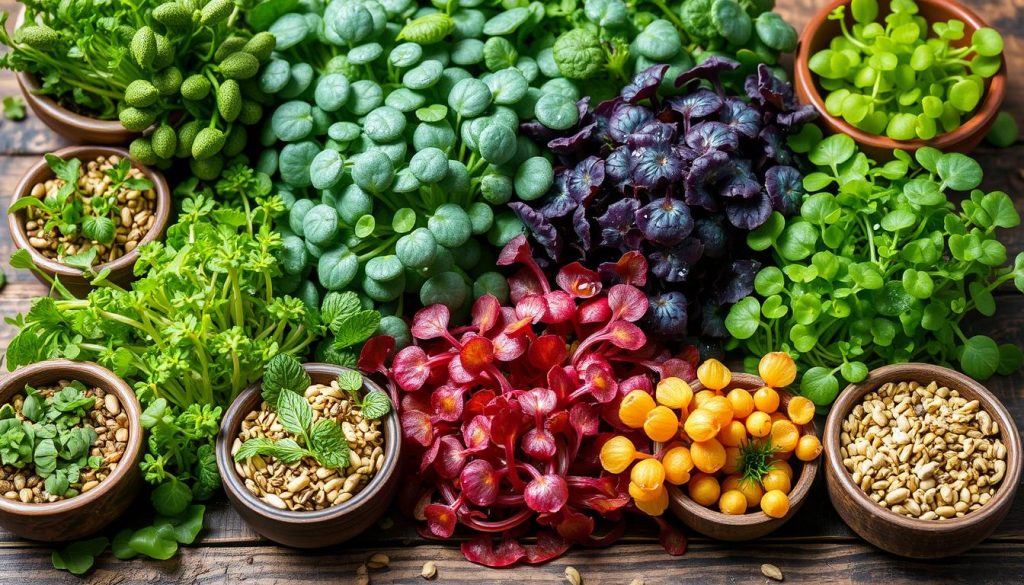
Potential Health Benefits
Microgreens are more than just a fancy garnish. They are full of nutrients that could boost your health. They have lots of polyphenols, antioxidants, and plant compounds. These can help keep your heart healthy.
Eating microgreens heart health might lower microgreens blood pressure and microgreens cholesterol levels. It could also cut the risk of obesity, which is key for a healthy heart.
Microgreens also fight against cancer with their strong antioxidants and phytochemicals, like microgreens sulforaphane. They are full of carotenoids, which help fight cancer too.
Improved Heart Health
Microgreens are loaded with microgreens antioxidants. These can protect your heart and blood vessels. Eating them might lower blood pressure, improve cholesterol, and reduce obesity risk. All these are good for your heart.
Cancer Prevention
The antioxidants and phytochemicals in microgreens, like sulforaphane, can protect cells from damage. They might lower the risk of some cancers. Microgreens also have carotenoids, which help fight cancer.
| Nutrient | Amount per 100g |
|---|---|
| Vitamin C | 103mg |
| Vitamin E | 1.4mg |
| Carotenoids | 1800µg |
| Sulforaphane | 32mg |
“Microgreens are not just a trendy garnish – they are packed with an impressive array of nutrients that may offer significant health benefits.”
Microgreens Side Effects
Microgreens are known for their nutritional value and health benefits. However, they can be at risk of contamination. Since they grow in unclean mediums, they might carry harmful bacteria like Salmonella or E. coli. This can be a big concern for food safety.
To lower this risk, producers and consumers must follow strict food safety rules. This means cutting the microgreens above the soil, washing them well before eating, and keeping the growing area clean. These steps help reduce the microgreens side effects linked to microgreens contamination.
People with weak immune systems, like the elderly, pregnant women, or those with health issues, should be extra careful with microgreens. They might face bigger risks from microgreens food safety issues. They should talk to their doctors before adding these greens to their diet.
Knowing the possible microgreens side effects and how to avoid them lets people enjoy these tasty and healthy greens safely. This way, they can stay healthy and enjoy the benefits of microgreens.
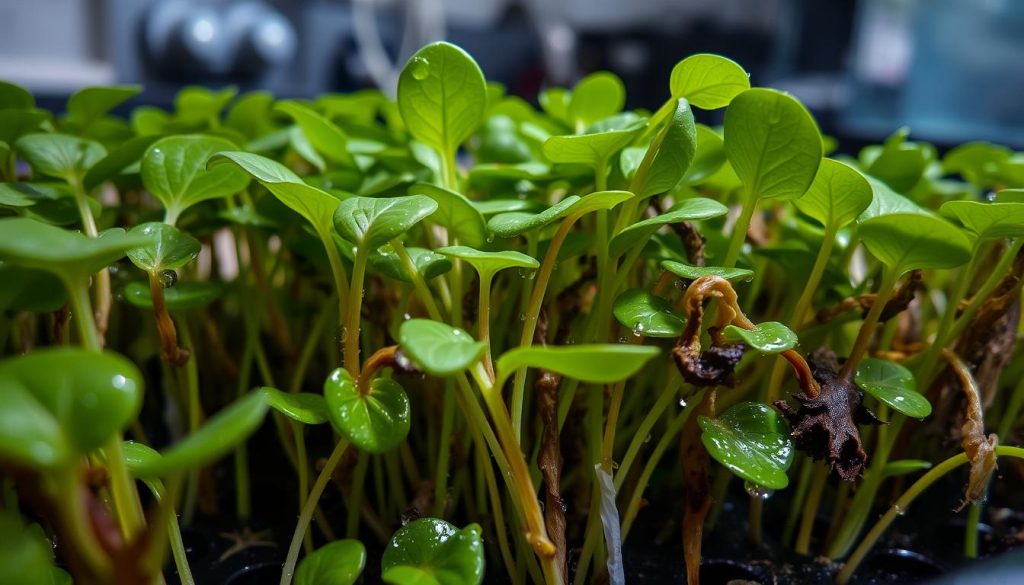
“Proper handling and storage of microgreens is crucial to ensure food safety and minimize the risk of contamination.”
Growing Microgreens at Home
Growing microgreens at home is rewarding and easy. You can enjoy their nutritional benefits with just a sunny windowsill or a small indoor setup. It’s a great way to have fresh greens right in your kitchen.
Choosing Quality Seeds and Soil
Start with high-quality, organic seeds and a nutrient-rich growing medium for microgreens. Don’t use low-quality or dirty materials to avoid bacteria or fungi. Choose seeds made for microgreens and a clean potting mix or soil-less medium for a healthy start.
Preventing Mold and Fungal Growth
Stopping mold and fungi is key when growing microgreens at home. Keep watering consistent and air flowing well, and watch for contamination signs. Picking microgreens that resist disease also helps prevent mold and fungi.
| Microgreen Variety | Germination Time | Harvest Time | Recommended Serving Size |
|---|---|---|---|
| Sunflower | 2-5 days | 7-14 days | 25 grams |
| Pea | 3-7 days | 10-18 days | 25 grams |
| Buckwheat | 2-4 days | 8-12 days | 40 grams |
Follow these tips for growing microgreens at home. You’ll get a steady supply of fresh, nutritious greens. Plus, you’ll keep contamination risks low.

Food Safety Practices
Keeping microgreens safe and high-quality is key, whether you grow them or buy them. Washing the microgreens well before eating is a crucial step. This removes any dirt or harmful stuff that might be there. When you handle microgreens, be gentle and don’t cut them too low, as that can bring in bad bacteria.
Proper Handling and Washing
Here are some tips to keep microgreens safe and clean:
- Wash the microgreens under running water, rubbing the leaves to get rid of dirt.
- Don’t cut the microgreens below the soil line to avoid bringing in harmful germs.
- Use clean hands or tools when handling the microgreens to stop bacteria from spreading.
- Put the washed microgreens in the fridge in a sealed bag to keep them fresh and safe.
By following these steps, you can make sure the microgreens you eat are safe and top-notch. This reduces the chance of getting sick from food.
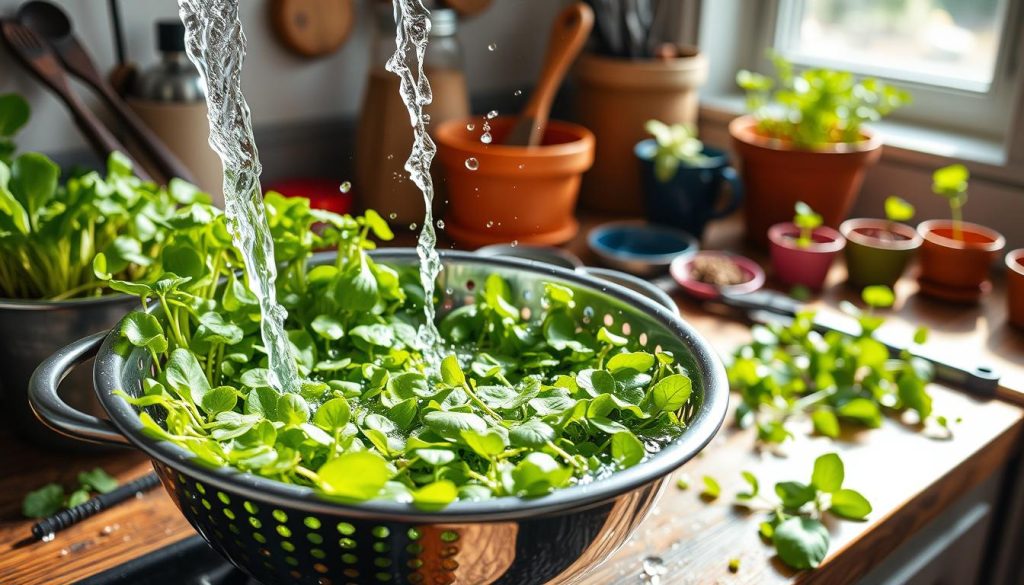
“The transformation of food systems for food security, nutrition, and affordable healthy diets for all is a global priority, as emphasized by the FAO, IFAD, UNICEF, WFP, and WHO.”
It’s vital to keep up with microgreens food safety, microgreens washing, and microgreens handling to protect people’s health. By sticking to these rules, you can enjoy microgreens’ health benefits without worrying about contamination.
Microgreens and Allergies
Microgreens are packed with nutrients but can cause allergic reactions. If you’re allergic to the plant from which a microgreen comes, you might react to it. For instance, if you’re allergic to sunflowers, you could react to sunflower microgreens too.
Some microgreens, like those from the Brassica family (broccoli, kale, radish), can cause allergies. These may lead to hives, itching, swelling, or trouble breathing. Others, like parsley and spinach, have oils and flavonoids that can cause skin rashes in people who are allergic.
It’s important to know your food allergies and avoid microgreens from those plants. If you think you’re having an allergic reaction, talk to a healthcare provider. This way, you can enjoy microgreens safely and avoid any bad reactions.
| Microgreen | Potential Allergy Concerns |
|---|---|
| Sunflower Microgreens | May trigger reactions in those with sunflower allergies |
| Brassica Microgreens (Broccoli, Kale, Radish) | May cause hives, itching, swelling, or difficulty breathing in some individuals |
| Parsley and Spinach Microgreens | Can lead to skin rashes due to essential oils and flavonoids |
| Peas, Chickpeas, Sorrel, Onions, and Mustard Microgreens | May not be suitable for those with gastrointestinal issues like bloating or acidity |
To safely enjoy microgreens, know your food allergies and talk to a healthcare professional if you’re unsure. With care, you can enjoy the health benefits these greens offer.
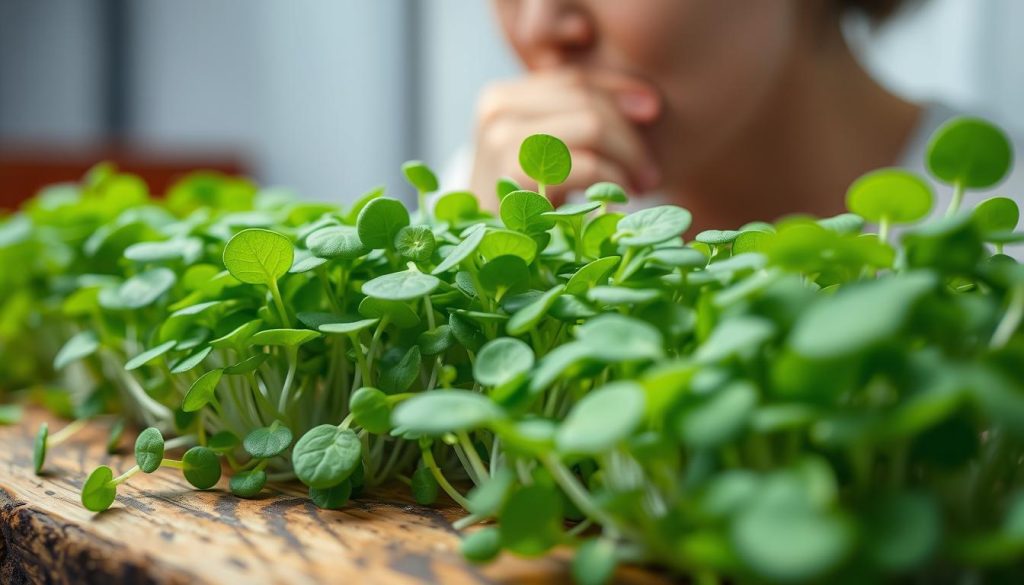
Incorporating Microgreens into Your Diet
Microgreens are super versatile and easy to add to many dishes. They can be used in salads, as garnishes, or even in smoothies and juices. These greens are full of nutrients and open up many cooking possibilities.
Salads and Garnishes
Microgreens are great for salads, adding flavor, color, and texture. They make any salad look and taste better, whether it’s simple or complex. They also work well as garnishes for soups, sandwiches, and other dishes, adding a fancy touch.
Smoothies and Juices
Adding microgreens to smoothies and juices is a smart way to get more nutrients. They blend in well with other ingredients without taking over the taste. Microgreens can make your green smoothies or vegetable juices more nutritious.
| Microgreen Type | Nutrient Highlights |
|---|---|
| Radish Microgreens | High in vitamins A, B, C, E, and K, as well as calcium, iron, magnesium, phosphorus, potassium, and zinc. |
| Pea Shoot Microgreens | Contain beta-carotene, vitamin A, vitamin C, folate, and fiber. |
| Sunflower Microgreens | Provide essential skin nutrients like zinc, vitamins A, B, D, E, sulforaphane, and antioxidants. |
Adding microgreens to your meals, like in salads, as garnishes, or in smoothies and juices, is a great way to enjoy their nutritional benefits and unique tastes.
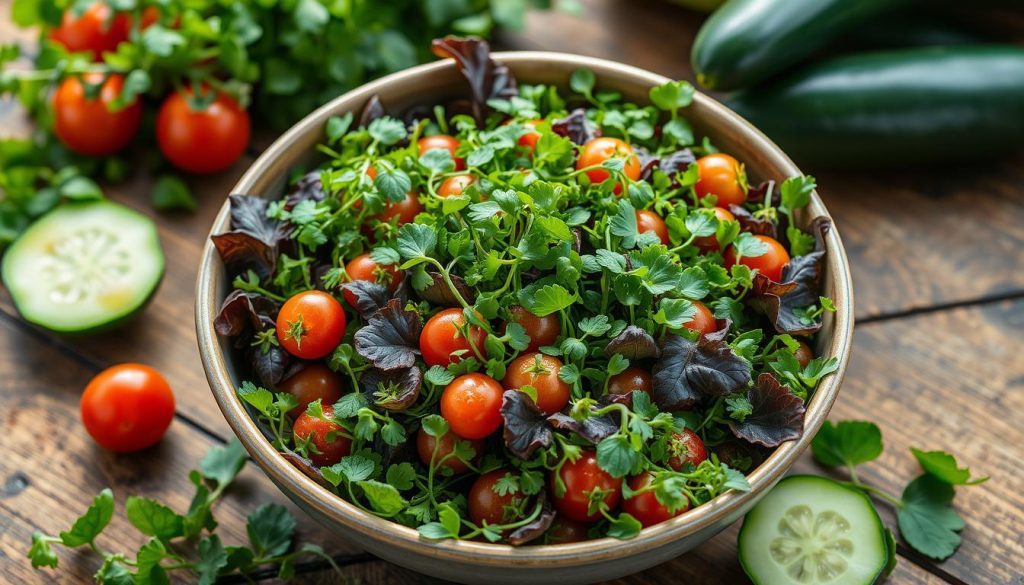
“Microgreens typically range from 1-3 inches tall, but they are packed with up to 40 times more nutrients than their mature counterparts.”
Sustainable Cultivation
Microgreens are a green and sustainable choice compared to regular vegetables. They need much less land, water, and resources to grow. Plus, they can be grown all year, cutting down on the need for big greenhouses or indoor farms.
Efficient Resource Utilization
Microgreens grow fast, ready in just 7-14 days. This quick growth means they use less water, energy, and land than regular crops. They also use water wisely, needing less storage and using it efficiently.
Promoting Urban Agriculture
Microgreens are great for city farming, fitting into small spaces. They bring people closer to their food, cutting down on transport emissions. Growing them locally also helps the environment and boosts local economies.
| Sustainability Metric | Microgreens | Traditional Crops |
|---|---|---|
| Land Use | Significantly less land required | More land-intensive |
| Water Usage | Efficient water uptake, less overall water usage | Higher water requirements |
| Energy Consumption | Reduced need for energy-intensive growing systems | Greater energy demands for greenhouses and controlled environments |
| Greenhouse Gas Emissions | Lower emissions due to reduced transportation and energy use | Higher emissions from longer supply chains and energy-intensive growing methods |
Growing microgreens is good for the planet. It saves resources, supports city farming, and lowers emissions. As people think more about their food choices, microgreens are becoming a top choice for those who care about the planet.
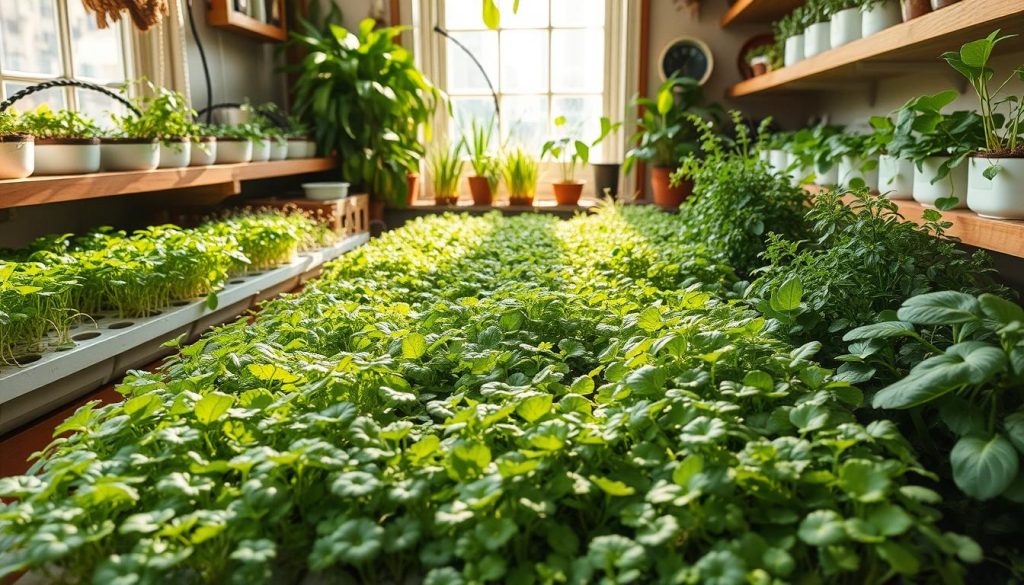
Microgreens in Culinary Applications
Microgreens are more than just a healthy addition to meals. They bring a unique flavor and texture to dishes. These small greens add a big punch to many foods.
Elevating Flavor Profiles
Microgreens come in many varieties, each with its own taste. You can find everything from peppery arugula to sweet beet microgreens. These greens can change the flavor of salads, sandwiches, and soups.
By adding microgreens to recipes, cooks can make dishes that look and taste great. It’s a fun way to be creative in the kitchen.
Enhancing Texture and Appearance
Microgreens also improve the texture and look of food. Their soft leaves and bright colors make dishes stand out. They’re perfect as a garnish or mixed into meals.
Their crunchy texture adds an interesting feel to both savory and sweet dishes. It’s a simple way to make your food more exciting.
For both chefs and home cooks, using microgreens in cooking is a great idea. It’s an easy way to enhance flavor profiles and make your dishes look better. Try different microgreens flavor profiles to take your cooking to the next level.

Microgreens Side Effects: What You Need to Know
Microgreens are mostly safe and healthy to eat. But, it’s good to know about the risks. They can carry harmful bacteria like Salmonella or E. coli if not grown or handled right.
The Food Safety Modernization Act of 2011 (FSMA) in the US says microgreens are not as likely to grow harmful bacteria quickly. But, they can still get contaminated. This means it’s key to handle and wash them properly.
Some people might be allergic to the plants that microgreens come from. If you eat them and have an allergic reaction, you might feel sick. Symptoms include vomiting, diarrhea, stomach pain, and feeling like you have the flu.
If you think you got sick from eating microgreens, get help right away. Call a doctor or a Poison Control Center. When growing them at home, make sure to avoid diseases like root rot and dampening off. These can happen in cool, wet places.
In short, microgreens are full of good stuff for your health. But, be aware of the possible risks and food safety issues. Handling and washing them right can help keep you safe.
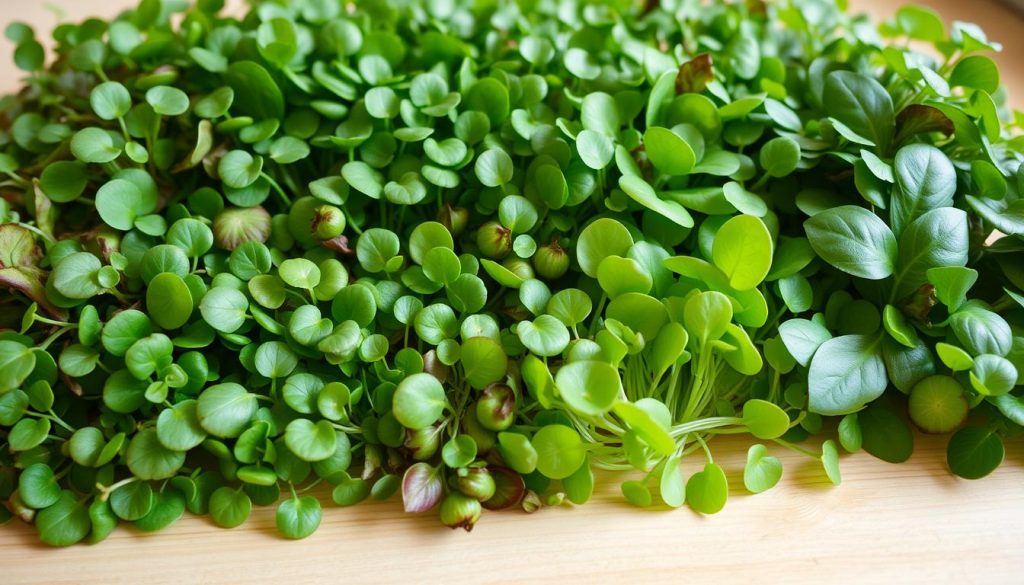
“Microgreens have been associated with recalls, but there are no reported food-borne outbreaks linked directly to their consumption.”
In Australia and New Zealand, the Food Standards Australia New Zealand Act 1991 (FSANZ) makes sure microgreens are safe to eat. In Canada, they follow the Canadian organic regulations for Microgreens Terms and definitions (CAN/CGSB).
Storing Microgreens
Microgreens are both delicate and delicious, but they don’t last long like mature vegetables. They usually last 5-10 days if stored right. To keep your microgreens fresh, it’s important to use the best storage methods.
Refrigeration and Moisture Control
Keeping microgreens in the fridge is key to making them last longer. Wrap them in a damp paper towel or put them in a sealed container with a bit of water. This keeps them moist, stopping them from drying out or getting limp. But, don’t let them get too wet or hot, as this can cause mold and bacteria to grow. This would make them not fresh and not safe to eat.
- Store microgreens in the refrigerator, ideally at a temperature between 35-40°F (2-4°C).
- Wrap the microgreens in a damp paper towel before placing them in an airtight container or bag.
- Alternatively, place the microgreens in a sealed container with a small amount of water in the bottom, just enough to keep the roots moist.
- Check on the microgreens regularly and replace the damp paper towel or water as needed to maintain the optimal moisture level.
By following these easy storage tips, you can make your microgreens last longer. This way, you can enjoy their fresh taste and health benefits for a longer time. Remember, how you handle and store them is key to keeping them good and safe.
“Microgreens have a short shelf life, but with the right storage techniques, you can enjoy their vibrant flavors and nutritional punch for longer.”
Cost Considerations
The cost of microgreens can be a big factor for many people. These greens are more expensive than regular greens because they need special growing conditions and a lot of work to harvest. They also have more nutrients.
Several things affect how affordable microgreens are. The type of microgreen matters because some need more care and resources. This makes them more expensive to produce. Also, growing them indoors costs more because you need special equipment and a controlled environment.
Where microgreens are grown also changes their price. In places with high labor and costs, they cost more. This is something to think about for those on a budget who want to eat these greens.
Even though microgreens are pricey, their health benefits and taste make them worth it. They are full of vitamins, minerals, and antioxidants. For those who can afford them, they are a good choice for a healthy diet.
As more people want microgreens, producers are finding ways to make them cheaper. They are improving growing methods, making supply chains more efficient, and using new technology. This could make microgreens more affordable for people who care about their health.
Availability and Accessibility
Microgreens are getting more common in stores, but not everywhere. You can find them in specialty stores, farmers’ markets, and some big supermarkets. But, if they’re not in your area, don’t worry. There are ways to get and enjoy microgreens.
Online Ordering and Home Growing
If you can’t find microgreens locally, try online or growing them at home. Many sellers ship nationwide, so you can get them delivered. Or, growing them yourself is easy and saves money. This way, you always have fresh microgreens.
Microgreens Availability Across the United States
- The Hamama Microgreen system, a popular home growing kit, is available for purchase at prices ranging from $35 to $69, with free shipping or additional shipping costs depending on the kit chosen.
- Microgreen availability and growth can be influenced by various environmental factors, such as temperature, humidity, and air circulation. Growers should monitor these conditions carefully to ensure optimal growth and prevent issues like mold or premature wilting.
- While microgreens do not require natural sunlight during their initial growth stages, they thrive in environments with the right temperature range, typically between 65°F to 85°F. Growers in extremely hot or cold climates may need to take additional measures to ensure their microgreens reach maturity.
Thanks to these options, more people can enjoy microgreens. You can choose local stores, online, or grow them yourself. This way, you can add these nutritious and tasty greens to your meals easily.
Conclusion
Microgreens are now a top choice for those looking for a superfood. They are packed with nutrients, antioxidants, and add unique flavors to dishes. But, it’s important to know about the risks of contamination and follow safe food practices when growing and eating them. Adding microgreens to meals can bring many health benefits and make food more interesting.
As people seek out foods that are both healthy and sustainable, microgreens are becoming more popular. They are great for fighting chronic diseases like heart disease, which kills millions each year. Microgreens are full of nutrients and antioxidants, making them a key part of a healthy diet.
Microgreens are more than just a trend. Studies show they can help prevent heart disease and even some cancers. By choosing to eat microgreens, people can improve their health and enjoy their food more. This makes microgreens a smart choice for anyone looking to eat better and feel better.